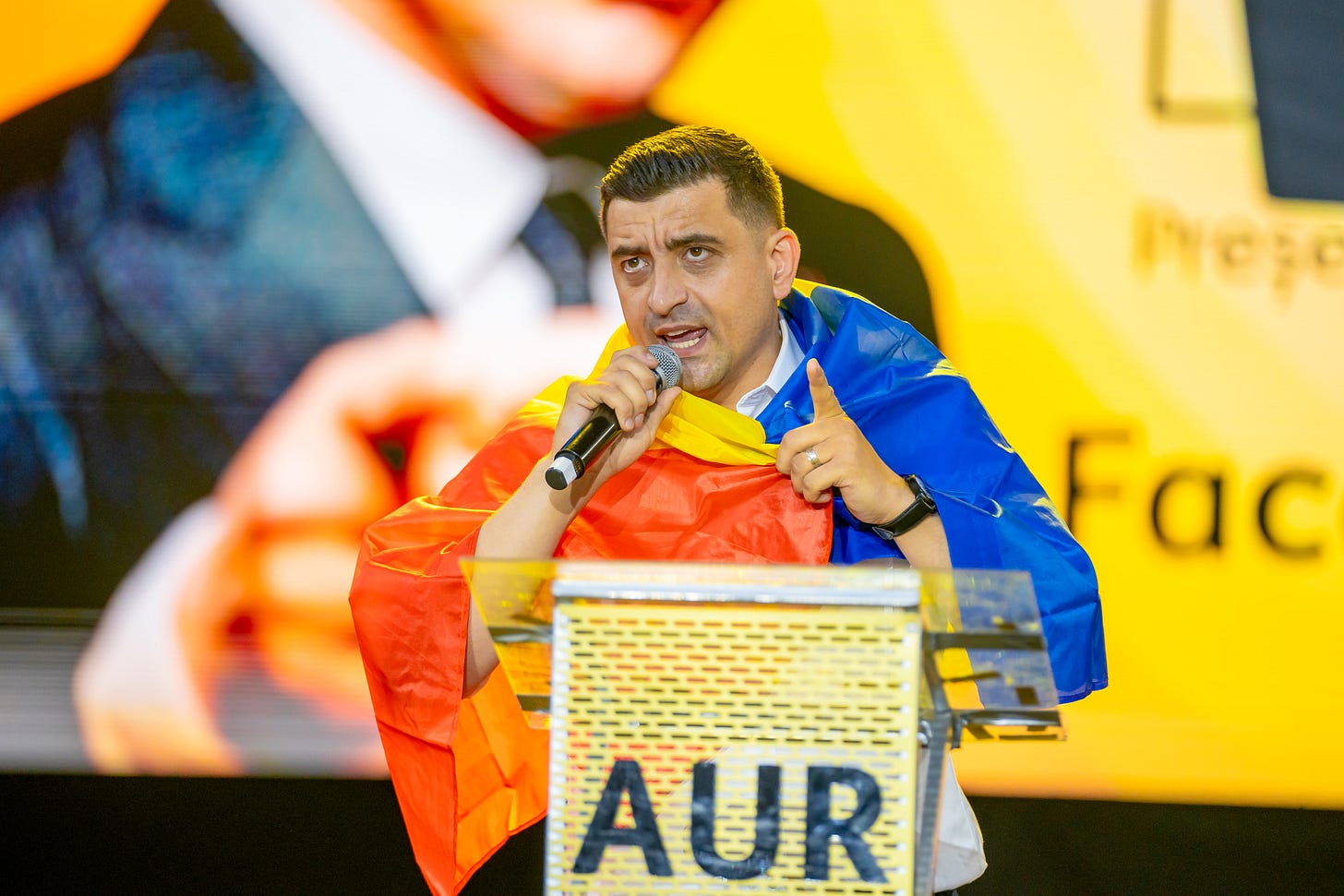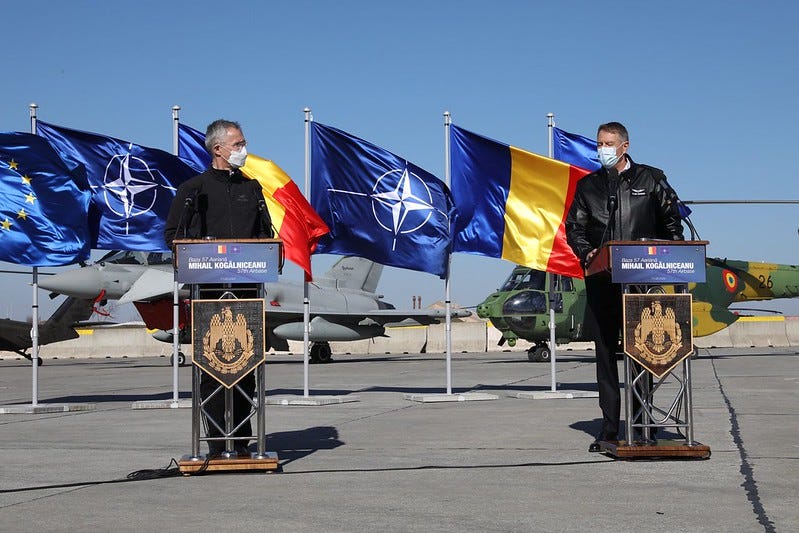George Simion's Right-Wing Case for NATO
Romania's next president opposes aid to Ukraine but backs collective defense against Russia. For a growing cadre of Eastern European Rightists, this is no contradiction

A decade ago, presidential elections in Romania would have barely registered in international news headlines. But times have changed, and so has Europe.
Although he still has one more round of voting ahead of him, in all likelihood, far-Right candidate and political black sheep George Simion will be Romania’s next president. Having left his challengers in the dust by winning 40% of the first round of voting in the country’s presidential election this Sunday, he is already leagues ahead of his liberal opponent Nicușor Dan, who will face off against Simion in the second round later this month. But as Dan well understands, the odds are stacked against him, and his uncontroversial, pro-EU vision feels like a scream into the void in the anti-establishment, populist landscape of Romanian politics in 2025. Simion, on the other hand, couldn’t feel more at home.
As a nationalist who has advocated for an end to military aid for Ukraine, the annexation of formerly Romanian territories of the country, and the absorption of the entirety of Moldova, Simion’s rise to power has been presented in much of the media as a challenge to NATO’s presence in Eastern Europe and a boon for Russia. Romania after all has played a significant role as a logistics hub for American military aid for Ukraine, coordinated Ukrainian grain exports through the Black Sea, and hosts some of the largest NATO bases in Europe, meaning that any disruption of the status quo by Simion could have major implications for the alliance.
But the real story is much more complicated, and tells us a great deal about where the populist Right along NATO’s eastern shield may be headed in years to come. Do Simion’s positions on Ukraine, his irredentist streak, and his focus on protecting ethnic Romanians being “abused” by Kyiv serve Russia’s interests in the war? Absolutely. But beneath his anti-Ukrainian ideology lies a commitment to NATO and the American-led order in Europe that is motivated not by protecting Ukraine from Russia, but by protecting Romania itself. In Simion’s eyes, and in those of a growing number of Rightists in countries on Russia’s frontier, the war in Ukraine is a lost cause. Instead, the task at hand is to hunker down within their own national borders, and with help from NATO and Trump, steel themselves for the greater war with Russia still to come.
If elected, Simion will surely find common cause on a host of issues with populists in his own neighborhood, namely Hungary’s Viktor Orbán and Slovakia’s Robert Fico. But putting him in the same ideological box with them is a lazy oversimplification, not least due to his history of feuds with Orbán over the rights of ethnic Hungarians in Romania. While Orbán and Fico are died-in-the-wool Russian sympathizers, Simion has positioned himself as an opponent of Putin — at least when it comes to protecting Romanian sovereignty. Simion said as much himself: “Putin’s Russia was and is one of the biggest threats for the European states, especially for us, for the Baltic states and for Poland,” he recently told Financial Times in March, and stated in April that only he can stop Trump’s potential pullout of US troops from Romania. His fear are not unfounded — since Russia’s invasion of Ukraine, Romania has seen Russian missiles fly through its airspace, witnessed drones falling on its territory, and been the target of Russian hybrid attacks. In an interview with Politico Europe that month, Simion said he hoped Trump’s peace process on Ukraine would come with “new security guarantees [for Romania] for the next 30 to 50 years” to protect it from Russian aggression.

Shortly before the election this month, Simion seemed to pivot, perhaps in a nod to Trump, and claimed that Russia is not a major threat to NATO as long as it remains unified. This deference to Trump appears throughout Simion’s policy positions on Romanian and regional defense, and points to the emergence of a novel form of Right-wing thinking on security that is increasingly taking hold along NATO’s eastern frontier — protecting the sovereign homeland of the nationalist imagination requires defending it against the Russian threat on the horizon, and the only way to do so is by aligning with American power. As a proponent of national self-interest, on very narrow terms, Trump is a perfect ideological compatriot for politicians like Simion, who are eager to appeal to his sovereigntist sensibilities to keep Romania covered by America’s security blanket for as long as possible.
This idea, that support for Ukraine should be traded for defending the nation much more directly under the auspices of a Trumpified NATO, can can be found among plenty of other parties along NATO’s eastern flank. Poland’s far-Right Confederation Party and to a lesser degree the former Polish ruling party PiS take nearly the same line, as does the ultranationalist Conservative People’s Party of Estonia, whose leaders have denounced Russia’s invasion of Ukraine and advocated for arming Estonia’s military while opposing military aid for Kyiv.
Implicit in this political position is the idea that Europe is too weak and the Russian threat too dire to waste time throwing precious resources at Ukraine, when the real fight will only begin after the guns fall silent in the Donbas. It is a policy founded on self-interest, but also desperation, in which the battle against the EU elite must urgently be balanced with the looming war with Russia on NATO’s own borders. Trump’s arrival in the White House has given politicians like Simion the chance to create a NATO they can feel more comfortable in — one where all members contribute as much as they can for the common good and where the battle lines run along the alliance’s borders, rather than through places like Ukraine or Kosovo.
Of course, lost in all of this is the fact that defending Ukraine from Russia is defending NATO states like Romania — Ukraine has been functioning as NATO’s forward defense shield since at least 2022, if not earlier. Plus, the ugly truth is that the longer Russia stays engaged in Ukraine, the more time the rest of Europe has to prepare for Russian aggression against NATO down the line. But for Simion and his counterparts in Poland, Estonia, and beyond, the defense of Ukraine has become too unsustainable, too costly, and too strategically murky to justify, while Ukraine itself remains far more useful for them as a punching bag in their nationalistic mythology. A third path then, situated between Russia and the liberal NATO mainstream, remains the only option at their disposal.
While this transatlanticist, anti-Russian brand of Right-wing populism is only in its infancy, there is no question that it will grow. Thinking across NATO is already beginning to shift from Ukraine to what will come afterward, even outside of nationalist circles. And as Putin readies his forces to wage both hybrid and very real warfare against frontline NATO states, the focus of Eastern European publics will soon shift too. Whatever happens next, Simion and politicians like him hope they will come out on the right side of history — emerging as saviors of their nations not just from bureaucrats in Brussels, but from the Russian war machine as well.



